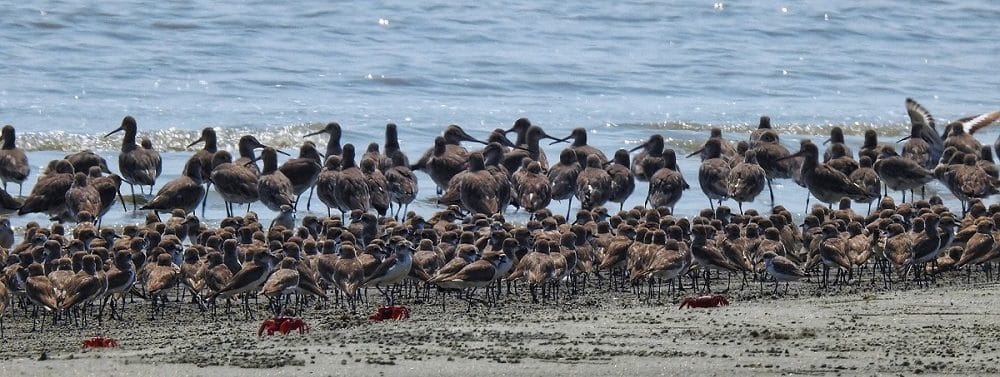It was a warm winter morning of February 2020 when my intern, Naim, and I observed eighteen individuals of a globally Endangered shorebird, the great knot, at Damar Char or the wave island in Bangladesh. Bangladesh is a land of water bodies and vast coastal mudflats and is geographically situated under two global air pathways for migratory birds: the East-Asian Australasian and Central Asian Flyways. These birds connect the world through their spectacular migration between northern breeding grounds and southern non-breeding grounds every year. Many of them traverse more than 10,000 km in this annual circuit.

Flock of Great Knot species while foraging (Credit: Irin Sultana)
Several coastal islands of Bangladesh turn into hotspots of many species every winter, and Nijhum Dweep National Park is one of them. Recognized as a globally Important Bird and Biodiversity Area (IBA), this national park is situated in the Bay of Bengal along the central coast of Bangladesh.
I was lucky enough to spend four months there conducting my field surveys. However, before starting my study, I was concerned about many uncertainties, including working permissions and safety at the island. Hardly any women came out of their houses there, and according to the Bangladesh forest department, I was the first female student to apply for a long duration stay. Local people of the island, therefore, were naturally curious about me and my work.
As a part of my master’s dissertation, I tried to understand how and why species chose this island as one of their regular wintering sites in Bangladesh. Every day, I used fishing trawlers to reach my study islands during the high tide period, walked through the shoreline or mudflats to reach selected sampling segments, and continued four hours of observations – two hours from the start of the high tide to peak low tide – on the presence of species and their foraging patterns. Our particular observation of the great Knot was an important finding as it directly hinted at the importance of the island for migrating species. Excited by our finding and calling it a day, we began returning to our boat which was approximately two kilometres away. We were, however, unaware of the dangers that awaited us soon after the excitement.

Observation period at the open mudflat stretch during low tide (Credit: Dr. Ashwin Viswanathan)
As we moved out of our observation site, the water levels started to rise covering the intertidal zone, which usually did not happen. We were beginning to realize that we could be soon caught in the spring tide (the greatest of all high tides) and that we needed to rush. Reaching halfway towards the shoreline where our boat awaited us, we noticed that the boat was moving away from us. The boatman struggled to save his boat from drowning against the powerful waves that lashed the tiny structure. Naim and I were trying to reach the shoreline as soon as possible but crossing the wide zone, filled with thick, knee-deep layers of mud was a challenge! In addition, our heavy instruments and tiredness weighed us down.
Within half an hour, half of our bodies were stuck in the water and mud. We were puzzled and couldn’t seem to find a way out. Suddenly, some fishermen noticed us as one of them called in Bengali, “sister, what are you doing? Please do not follow this straight path. Both of you may drown. So stop there, we are coming to save you guys.”
Immediately, four of them jumped into the water. Two of them swam to reach our boatman, and the other two rushed towards us. After about 20 minutes, they reached us and collected all our instruments and bags. This gave us a huge relief! Then, they guided us across the mudflats through a different path, where water levels were relatively low. Finally, with their help, we were able to reach the boat.
Like that unforgettable day, every single day of my whole study period was full of so many experiences and excitements. In the beginning, it was very challenging for me to conduct this work but the scenario gradually changed when I started to talk to people who were interested in my work. In the end, in spite of so many challenges, I was overwhelmed by the hospitality of the surrounding people and the success of our work. We recorded a remarkable diversity of 33 shorebird species and around 20,000 individual birds, with globally important and rare sightings including spoon-billed sandpiper and Nordmann’s greenshank.
My results reinforce the understanding that the Nijhum Dweep National Park area is a globally important site for wintering shorebirds. My findings also added some insights to understand their winter habitat selection which may add additional points for further monitoring of this site to protect and replenish such habitats for these fascinating species. Besides, I feel really blessed by receiving enormous rewards, not only from my field observations but also from understanding the coastal ecosystem and how local communities are the most important element for executing any research, management, and conservation plans.


